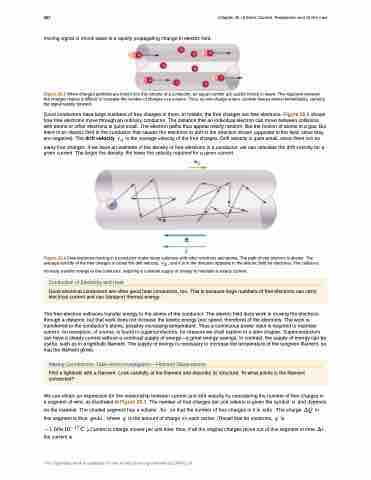Page 894 - College Physics For AP Courses
P. 894
882 Chapter 20 | Electric Current, Resistance, and Ohm's Law
moving signal or shock wave is a rapidly propagating change in electric field.
Figure 20.5 When charged particles are forced into this volume of a conductor, an equal number are quickly forced to leave. The repulsion between like charges makes it difficult to increase the number of charges in a volume. Thus, as one charge enters, another leaves almost immediately, carrying the signal rapidly forward.
Good conductors have large numbers of free charges in them. In metals, the free charges are free electrons. Figure 20.6 shows how free electrons move through an ordinary conductor. The distance that an individual electron can move between collisions with atoms or other electrons is quite small. The electron paths thus appear nearly random, like the motion of atoms in a gas. But there is an electric field in the conductor that causes the electrons to drift in the direction shown (opposite to the field, since they are negative). The drift velocity �� is the average velocity of the free charges. Drift velocity is quite small, since there are so
many free charges. If we have an estimate of the density of free electrons in a conductor, we can calculate the drift velocity for a given current. The larger the density, the lower the velocity required for a given current.
Figure 20.6 Free electrons moving in a conductor make many collisions with other electrons and atoms. The path of one electron is shown. The average velocity of the free charges is called the drift velocity, �� , and it is in the direction opposite to the electric field for electrons. The collisions
normally transfer energy to the conductor, requiring a constant supply of energy to maintain a steady current.
The free-electron collisions transfer energy to the atoms of the conductor. The electric field does work in moving the electrons through a distance, but that work does not increase the kinetic energy (nor speed, therefore) of the electrons. The work is transferred to the conductor's atoms, possibly increasing temperature. Thus a continuous power input is required to maintain current. An exception, of course, is found in superconductors, for reasons we shall explore in a later chapter. Superconductors can have a steady current without a continual supply of energy—a great energy savings. In contrast, the supply of energy can be useful, such as in a lightbulb filament. The supply of energy is necessary to increase the temperature of the tungsten filament, so that the filament glows.
We can obtain an expression for the relationship between current and drift velocity by considering the number of free charges in a segment of wire, as illustrated in Figure 20.7. The number of free charges per unit volume is given the symbol � and depends
on the material. The shaded segment has a volume �� , so that the number of free charges in it is ��� . The charge �� in this segment is thus ���� , where � is the amount of charge on each carrier. (Recall that for electrons, � is
����������� � .) Current is charge moved per unit time; thus, if all the original charges move out of this segment in time �� , the current is
Conduction of Electricity and Heat
Good electrical conductors are often good heat conductors, too. This is because large numbers of free electrons can carry electrical current and can transport thermal energy.
Making Connections: Take-Home Investigation—Filament Observations
Find a lightbulb with a filament. Look carefully at the filament and describe its structure. To what points is the filament connected?
This OpenStax book is available for free at http://cnx.org/content/col11844/1.14


